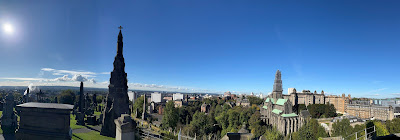Day 11: September 25, 2024 (New day, new hostel, new challenges)
(by Tugba and Rebecca)
We woke up in a new hostel; and for some of us it was challenging to cope with the new environment. As people were climbing out of their beds, they started to notice strange things in the room: bizarre and unidentifiable objects were discovered under beds. Other people had to deal with a shower which had a very free will because it turned from boiling hot water to ice cold water within seconds. A few faced the challenge of finding the hostel’s kitchen in the maze of floors, lounges and rooms to prepare their breakfast.
The class assembled at the lobby at 9:30 am and, with a rather long walk, we arrived at the Necropolis where Joel and Mila had their guided tour an hour later. We gathered at the end of the so-called Bridge of Sighs, and were told that this site is the biggest and oldest graveyard of Scotland. After a short overview, Mila and Joel guided us through the cemetery and stopped every now and then to dive into their topic more deeply. We learned that the term Necropolis describes an old graveyard where no new graves from nowadays can be found. Necropolis translates into “city of the death”. Also interesting was the fact that the hierarchy of the Glaswegian society of the 19th century can also be found on this cemetery. At the top of the hill the upper-class had the right to be buried, while the working class as well as the Jewish and people with low status or repute were entombed at the foot of the Victorian graveyard’s hill.
Our tour guides gave us the difficult task to search John Strang’s gravestone. As it turned out it was not as difficult as predicted because after just five minutes, Vivienne was so lucky to peak it out of the vast number of pillars and stones. (John Strang was the city chamberlain and the founder of the Necropolis.)
Right opposite the Necropolis we had around 25 minutes to explore the oldest still existing building of Glasgow: The Provand’s Lordship which was built in 1471. Troughout the years it served as an inn, shop, private home as well as cathedral and nowadays it is open for all and serves as museum.
Some of us were so tired that they sat on the cozy bench and watched the short documentary about the building up to three times, (comment Ms Ruf: I thought you watched the documentary three times because you were enthusiastic about the topic…??) while the ones who were still full of energy preferred to walk through the museum, skimming through the short information texts or have a look at the paintings of the city of Glasgow by Thomas McGoran.
Our next stop was the Merchant City. There we could enjoy a two-part presentation. The first part, which talked about the history and the different sites of the Merchant City, was presented by Marcela and Mio. They taught us that this area served as housing of merchants and tobacco lords in the 18th century while today it is an area with a big variety of shops, and it is a popular get together spot for locals. As we were guided through the accommodation we could marvel at the Victorian and Georgian architecture of the old warehouses. The “Scotia Bar,” which is the oldest pub of Glasgow and known for its vibrant and opened minded atmosphere, was a tempting spot for a few (minors) among us.
In the second part we were introduced to the two tobacco lords William (Rea) and Archibald (Sofia). At first the two rather conceited gentlemen from the 18th century were judging us for our appearance describing us as “crusty teenagers from 2024”. But after a while, they opened up and explained why Glasgow gained its wealth through the trade of tobacco. They told us that Glasgow is the nearest port from the United Kingdom to the United States, so when the UK started to colonize and to build their huge trade system, it used the port of Glasgow. A mystical object from the future (2024) forced the two tobacco lords to admit that there were bad sides of their trade as well.
For the lunch break we all spread out in different directions and then met again at a quarter to three for the afternoon program. We walked together to the University of Glasgow where we had the last presentation for today by Lou and Ylva. They told us that Mary Queen of Scots was very important for its existence because of her financial support. Further on they explained the university’s motto: “via veritas vita” which translates into “the way the truth the life”. Interesting to learn was that James Watt, the inventor of the steam engine used to study at this university. They wrapped up their presentation with a quiz which was probably inspired by the show “1, 2 oder 3” and was a lot of fun.
After the final guided tour, we had around half an hour to explore the Hunteranian Museum which is located on the university campus. Once again a few preferred the sofa-like benches, and the kids play and drawing area over the actual exhibition. But a few curious students still explored the crystals, ammonites, butterfly collection or preserved lungs.
A big challenge of all of us today was the “camps tiredness” which settled slowly but surely into our bones. It hindered us to show motivation especially for walking. (comment Ms Ruf: yes??)
Back at the hostel some went straight into their beds for a late afternoon nap, while others worked on their history portfolios, prepared dinner, planned a big Dungeons and Dragons session or organized some hair dye to make a makeover.












